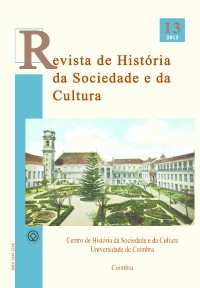Please use this identifier to cite or link to this item:
https://hdl.handle.net/10316.2/39394| DC Field | Value | Language |
|---|---|---|
| dc.contributor.author | Faria, Ana Santiago de | - |
| dc.date.accessioned | 2016-09-07T11:09:17Z | |
| dc.date.accessioned | 2020-09-29T20:23:23Z | - |
| dc.date.available | 2016-09-07T11:09:17Z | |
| dc.date.available | 2020-09-29T20:23:23Z | - |
| dc.date.issued | 2013 | - |
| dc.identifier.issn | 1645-2259 | - |
| dc.identifier.issn | 2183-8615 (digital) | - |
| dc.identifier.uri | https://hdl.handle.net/10316.2/39394 | - |
| dc.description.abstract | O processo inquisitorial foi um dos aspetos mais polémicos da História da Inquisição. Alvo preferencial das críticas dos cristãos-novos, que alegavam a especificidade do procedimento português, é ainda hoje considerado pela historiografia como um procedimento de natureza excecional. Partindo da premissa que um correto entendimento do processo inquisitorial passa por enquadrá-lo como parte da cultura jurídica europeia de que é originário, propõe-se um estudo comparativo entre o processo praticado no Tribunal do Santo Ofício Português, tal como consagrado no Regimento do Santo Ofício de 1640, com o direito processual penal secular, regulado nas Ordenações Filipinas. Através de uma análise comparativa que autonomiza, por um lado, a marcha do processo, por outro, a teoria da prova, pretende-se aferir quais as semelhanças e diferenças existentes entre as duas justiças, nomeadamente se institutos e práticas jurídicas similares possuíam a mesma natureza, enquanto normas gerais ou excecionais. | por |
| dc.description.abstract | The Inquisitorial Process was one of the most controversial aspects of the History of the Inquisition. Main target of criticism by the New Christians, who claimed the uniqueness of the Portuguese procedure, it is still today regarded by the historiography as a procedure of exceptional nature. Considering that a correct understanding of the Inquisitorial process envolves framing it within the european law culture from which it derives, this paper proposes a comparative study between the procedures practiced by the Portuguese Tribunal of Holy Office, as enshrined by the 1640s Regimento do Santo Ofício, and those practiced by the Secular courts, regulated by the Ordenações Filipinas. Through a comparative analysis that on one hand empowers the conduct of proceedings, and on the other, the proof theory, we aim to assess the similarities and differences between the two legal institutions, namely assessing if similar legal institutions and practices had the same nature, as general or exceptional rules. | eng |
| dc.language.iso | por | - |
| dc.publisher | Centro de História da Sociedade e da Cultura | - |
| dc.rights | open access | - |
| dc.subject | Inquisitorial process | eng |
| dc.subject | Secular courts process | eng |
| dc.subject | Criminal procedure | eng |
| dc.subject | Processo inquisitorial | por |
| dc.subject | Processo penal secular | por |
| dc.subject | Processo Penal | por |
| dc.title | Processo inquisitorial e processo régio: semelhanças e diferenças (o caso português) | por |
| dc.type | article | - |
| uc.publication.collection | Revista de História da Sociedade e da Cultura vol. 13 | - |
| uc.publication.firstPage | 269 | - |
| uc.publication.lastPage | 289 | - |
| uc.publication.location | Coimbra | - |
| uc.publication.journalTitle | Revista de História da Sociedade e da Cultura | - |
| uc.publication.volume | 13 | por |
| dc.identifier.doi | 10.14195/1645-2259_13_12 | - |
| uc.publication.section | Artigos | - |
| uc.publication.orderno | 13 | - |
| uc.publication.area | Artes e Humanidades | - |
| uc.publication.manifest | https://dl.uc.pt/json/iiif/10316.2/39394/247587/manifest?manifest=/json/iiif/10316.2/39394/247587/manifest | - |
| uc.publication.thumbnail | https://dl.uc.pt/retrieve/11849143 | - |
| item.fulltext | With Fulltext | - |
| item.grantfulltext | open | - |
| Appears in Collections: | Revista de História da Sociedade e da Cultura | |
Files in This Item:
| File | Description | Size | Format | |
|---|---|---|---|---|
| processo_inquisitorial_e_processo_regio.pdf | 2.41 MB | Adobe PDF |  |
Items in DSpace are protected by copyright, with all rights reserved, unless otherwise indicated.
